 Defibtech Lifeline AED
Defibtech Lifeline AED
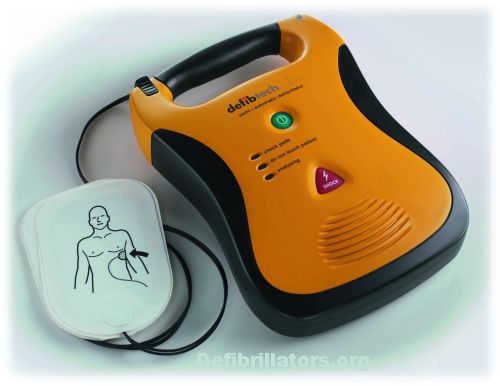
The Lifeline AED is Defibtech’s only model available in the United States, but it certainly doesn’t disappoint. It’s unique black and yellow color scheme is a design that demands attention. The shape is reminiscent of a Speak & Spell — but the child’s toy looks downright complicated compared to this AED (and that’s definitely a good thing).
There is nothing delicate looking about the Lifeline. It just looks rugged. It has two large buttons on the front: on/off and shock. What else do you need? Three LEDs and a large speaker round out the front of the unit. The handle, sides and bottom are covered in a rubberized material which helps it grip surfaces and survive small drops and bumps without significant cosmetic damage. Defibtech strikes a good balance between being rugged enough for industry and public safety, but simple enough for minimally-trained responders.
The Defibtech Lifeline AED
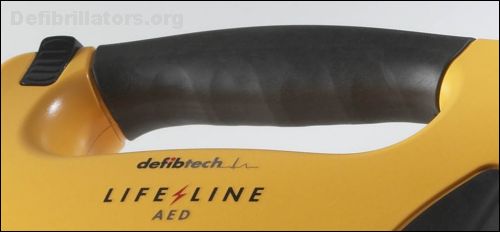
One feature we noticed right away was the handle. It features a large rubberized grip with finger indentations which makes carrying the Lifeline easy, even with work gloves. If you plan to place the AED in an industrial setting or other area where safety gloves are regularly worn, this could be an important feature. The Lifeline is easy to carry and feels solid in your hand. Some AEDs lack a built-in handle which make them more difficult to carry securely with only one hand, especially without a carrying case.
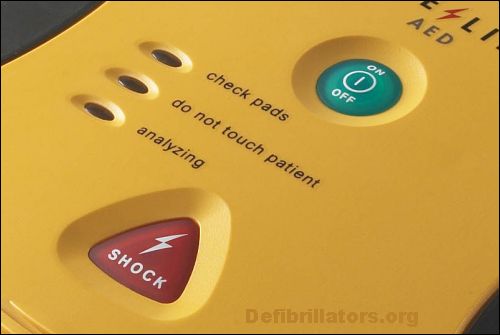
The rubberized buttons on the front panel of the Defibtech Lifeline AED are very large. They are backlit for easy visibility in low-light conditions. They are also recessed to prevent them from being accidentally pushed.
In addition to voice prompts, three LEDs indicate the status of the unit. If, for example, the pads are not making proper contact with the chest, the “check pads” indicator will light. Other indicators include “do not touch patient” and “analyzing.” As with most AEDs, these visual clues can be especially useful for hearing impaired users or when the AED is used in a very noisy environment.
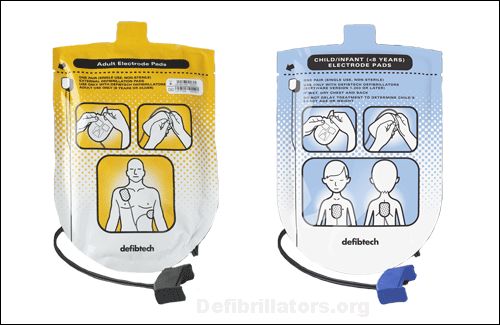
How It Works: Turning it on and connecting the electrode pads
The AED is powered on by pressing the large green button on the front. A calm voice states, “Call for help. Remove pads from package in back of unit. Apply pads to patient’s bare chest, as shown.” These instructions are simple and universal. First, it reminds the user that they need to call 911 for additional help (if they have not already done so). Then it tells a user who may not be familiar with the AED where to find the electrode pads and that they need to be opened. It also reminds them that they need to bare the chest before they place the electrodes. The device will continue to coach the user to “apply pads” until the action is complete.
If the pads are not connected or are applied incorrectly, the Defibtech Lifeline will begin to guide the user through the process of correcting the problem. Two error messages, “Plug in pads connector” and “Plug in and apply pads” indicate problems with the electrode connector, the lead wires, or the electrode pads themselves. At this point the user should attempt to reset the plug connector and confirm that the pads have been applied to the patient’s bare chest.
Other error messages include, “Poor pad contact to patient. Press pads firmly,” and “replace pads.” Even though the adhesive on the electrode pads works very well, sometimes due to excessive chest hair or sweating they may have been applied too lightly or not adhere appropriately. In this scenario, the AED attempts to help the user to press against them to attempt to make a better connection. In other situations, the foil pad package may have been breached causing the adhesive gel on the electrode pads to dry out. This could result in an incorrect impedance condition which would necessitate replacing the pads with a new set. Though it’s rare to have a situation when the pads themselves are non-functional, it’s always a good idea to keep a spare set of pads ready to go – especially if the AED is stored in an environment where the pad packaging could be exposed to wear.
If the AED senses a failure to correct the problem, it will say “pausing for CPR” and take a two-minute break from attempting corrective action. Although defibrillation is essential, this helps to make sure that the user doesn’t spend the entire time trying to correct a problem and neglect another important part of resuscitation: getting oxygenated blood to the brain.
How It Works: Analyzing the heart rhythm
When the Defibtech Lifeline senses that the pads have been properly applied, it will begin to automatically analyze the patient’s heart rhythm to look for the presence of a shockable rhythm (ventricular fibrillation or ventricular tachycardia). During this process it will advise the user that it is “analyzing heart rhythm” and “do not touch the patient.” This process takes only a few seconds.
During the rhythm analysis, the AED requires that the patient not be touched or moved, and that there is not excessive electromagnetic interference in the area. While not likely, it is possible that devices such as two-way radios and even mobile phones operated in very close proximity to the AED could cause interference. If the device indicates that that user must “stop motion” or “stop interference,” potential sources of interference should be removed.
When the AED has determined whether the heart rhythm is shockable or not, it will indicate it’s finding with one of two audio messages: “shock advised” or “no shock advised.” If the AED determines that a shock is advised, the ECG analysis will continue as the unit charges while preparing to deliver the shock. During this process the AED will state that it’s “charging” and that the user should continue to “stand clear.”
If no shock is advised, the AED will then instruct the user that “it is safe to touch the patient” and that they should “check airway, check breathing” and “if needed, begin CPR” for two minutes.
How It Works: Shocking the patient
When the AED is fully charged and the heart rhythm analysis indicates a shockable rhythm, the device will repeatedly prompt the user to “press the flashing shock button.” Once the user has verified that everyone is clear of the patient, they press the flashing red button and the shock is immediately delivered. The AED will then advise that “it is safe to touch the patient” and to “begin CPR now.”
If the flashing red shock button is not pressed within thirty seconds, or if the heart rhythm changes while waiting for a shock to be delivered, the unit will advise “shock cancelled” and the unit will disarm itself. The operator may do this manually by pressing the on/off button on the front of the AED.
While fully automatic defibrillators that go through the process of charging and shocking automatically may be seen by some as eliminating an extra step of having to press the shock button, we believe that having a manual shock button is an important safety feature. While using an AED is very safe, injury can occur if the operator or a bystander is touching the patient while the shock is being delivered. By forcing the user to perform the manual step of pressing a shock button, this step helps insure that the operator is indeed visualizing that everyone is clear.
AED Maintenance and Self-Tests
The Defibtech Lifeline uses a replaceable lithium 9-volt battery to perform daily, weekly, and monthly self-checks of the operational readiness of the AED. This is done automatically without input from the user and the status is displayed via the Active Status Indicator LED display on the top of the device. This allows the user to quickly determine whether the device is operational: green for ready, red for trouble. Users should verify on a daily basis that the indicator is flashing green.
In addition to daily checks, monthly checks should include checking the general condition of the AED and making sure that the battery packs and electrode pads are not expired (or expiring soon).
Event Recording and Review
The Defibtech Lifeline AED records EKG data and event information, and allows for PC-based playback via Defibtech’s free Event Review Software (DAC-600, Windows only). With an optional data card, the AED is able to record up to 12 hours of EKG and event information. With the optional data card, you can also enable an audio record feature, however this reduces the recording time to just over an hour and a half. Still, that should be more than enough time for most cardiac arrest events.
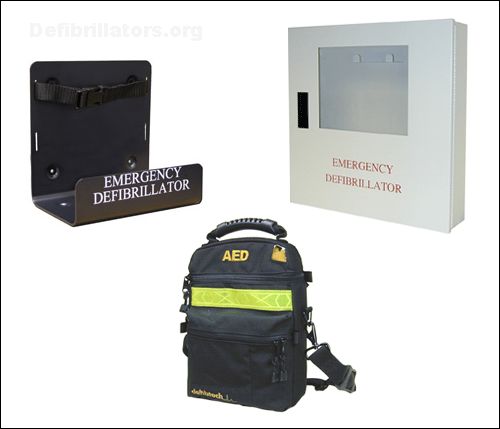
Accessories
A variety of accessories are available for Defibtech AEDs including wall cabinets and mounts, carrying cases, signage, and more.
The large wall mount case DAC-210 and an alarmed version, the DAC-220, are constructed of painted metal and are specially designed to accomodate the Defibtech Lifeline AED. An oversized plexiglass window allows the user to see the AED without opening the door. It also allows you to see the green flashing LED making it easy to determine the AEDs status. It is mounted using pre-drilled holes in the back. Mounting hardware is not included. At 18 in. by 18 in. by 4 in., it is relatively low-profile and doesn’t obtrude significantly into the room or hallway. The alarmed version activates when the door is opened, notifying people in the area of the emergency and deterring would-be thieves. The enclosed cabinet protects the AED and deters children and others from tampering with it.
A smaller, less expensive mounting bracket (DAC-200) is available for areas where controlling access is less of a concern. At 9 in. by 9 in. by 6 in., it is smaller than the enclosed cabinets but protrudes an additional two inches from the wall. It is less suited for hallways, schools, and other places where a more secure housing may be desired.
If you plan to deploy the AED in a vehicle or another place where it may get moved around a lot, there are two good options. The first is a soft carrying case (DAC-100) and the other is a hard plastic Pelican-style case (black DAC-110 and larger yellow DAC-111). The soft care features a zippered top opening to access the AED and a zippered front pocket to store extras such as gloves, CPR mask, an extra set of adult or pediatric pads, or a spare battery. The hard cases made of high-impact ABS plastic are water-proof and designed for harsher environments such as boats, industrial settings, or other environments where the AED could be exposed to water, dust, or other contaminant.
Proper signage is an important part of deploying an AED. Defibtech makes several AED signs including a three-way wall sign (DAC-230) and two-way wall sign (DAC-231). The three-way wall sign is mounted on a flat surfacel and designed to be seen from a full 180 degrees. It is well suited for mounting above the AED in large rooms where people may approach the AED from several angles. Two decals, one that indicates “Facility Equipped with AED” and the other “Vehicle Equipped with AED” are also available. All signage features the universal AED symbol.
10-Year Cost of Ownership
The Defibtech Lifeline AED retails for $1,495. The AED (DDU-100A) does come with a set of adult electrode pads and a standard battery. Over ten years, you would need to buy one additional 5-year battery ($149 each) and four additional 2-year adult electrode pads ($38 each). Total cost of ownership would be $1,796 (or about $180 per year). Adding pediatric capability (< 8-years-old) would require five sets of pediatric electrode pads ($99 each). This would increase the ten year cost to $2,291 (or about $229 per year). The Defibtech Lifeline comes standard with a 5-year warranty.
Defibtech Recalls
In 2007, Defibtech initiated a voluntary recall of their Lifeline and ReviveR AEDs. According to a company press release, a problem was discovered with the self-test software that could cause a low battery condition to go unnoticed. Defibtech sent users a special data card which upgraded the software when inserted into the AED. This allowed the unit to be fixed by the end-user in the field without having to return it to the manufacturer for service.
Although serious, occasional medical device recalls are not uncommon. We include information about AED recalls in our reviews to help you make an informed decision. Recall “red flags” include those that seem to indicate a pattern of problems or that are not handled in a professional and timely manner.
Specifications Overview
- Dimensions and Weight
8.5 in. (22 cm) by 11.8 in. (30 cm) by 2.7 in. (7 cm). The AED weighs 4.2 lbs. (1.9 kg) with the standard battery and 4.4 lbs. (2.0 kg) with the large capacity battery.
- Charge Time
The Lifeline AED charges in less than 6 seconds with the larger capacity battery, and under 9 seconds with the standard capacity battery.
- Shock Waveform
The AED uses an impedance compensated biphasic truncated exponential waveform.
- Energy Settings
150 J (into a 50-ohm load)
- Operating Temperature, Humidity and Altitude
32 to 122F (0 to 50C) with a relative humidity of 5-95% at an altitude of -500 to 15,000 ft. (-150 to 4500 m).
- Standards
MIL-STD-810F 500.4
MIL-STD-810F 514.5
MIL-STD-810F 516.5
RTCA/DO-160D, Section 8.8.2, Cat R, Zone 2, Curve G
RTCA/DO-160D, Section 8.8.2, Cat H, Zone 2, Curves B & R
IEC 60529 Class IP54
EN61000-4-2: 1998
EN60601-1-2: 1993
EN55501: 1998, Group 1, Level B
EN61000-4-3: 1998, Level 3
Downloads